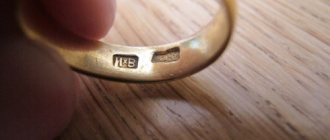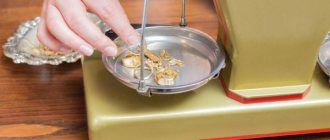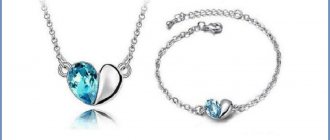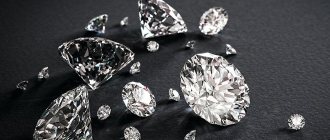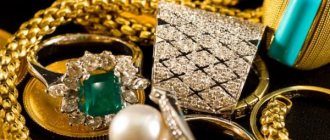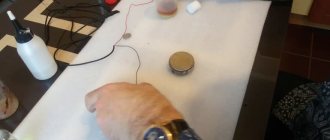Distinguishing gold from fake gold at home is not as difficult as it might seem at first. Everyone knows the “tooth test” method, but in reality it is of little use - after all, only pure gold is soft. And jewelry or products made of pure metal are almost impossible to find. Whether to check gold or not is a personal matter for everyone, but we still advise you to take a closer look at the jewelry to avoid unpleasant moments. A few simple methods that we will talk about today are worth adopting - because you never know where new knowledge will come in handy.
Characteristics of precious metal
Gold is a metal that is resistant to external factors, durable and beautiful, but at the same time very soft. That is why there is no jewelry made from pure precious metal; other chemical elements are necessarily added to the alloy:
- yellow gold - a combination of equal parts of silver, copper and gold itself;
- red gold - 25% copper;
- white gold - contains 32% gold, the rest is an alloy of platinum and nickel.
Pure gold is marked with a purity of 999. The 958 purity contains 96.3% pure gold. Such materials are rarely used for making jewelry - they are very soft.
What is the difference between gold and gilding
Gilding - metal coated with a layer
gold. Different countries have certain requirements for the manufacture of gold-plated products.
On the market you can often find gold-plated jewelry, which is based on silver or an alloy of metals.
The concept of medical gold appeared thanks to marketing tricks. The alloy can be coated with a thin layer of gold, and sometimes can be made without it. The medical alloy is hypoallergenic and durable. Additional coating only decorates the product.
How to check gold for authenticity: 10 ways to recognize a fake
It is believed that you can check the authenticity of gold products yourself: no special devices are needed for this. But are all folk methods as effective as they say? Having examined each of them in more detail, it becomes clear which “test” should be trusted and which should not.
Sherlock's method
Good fakes cannot be identified visually: they have samples on them, and they are painted in such a way that there is nothing to complain about. However, the punishment for counterfeit products with a stamp is more severe, so not all “specialists” decide to make such stamps. Armed with a magnifying glass, you need to carefully examine the product from all sides under bright light (from a window or a powerful table lamp). Signs of a fake:
- absence or unclearness of the manufacturer's imprint and/or sample - on a genuine product these marks are visible even with the naked eye;
- the presence of discolored areas - real gold is colored evenly, if in some parts of the product (usually along the edge) the color has worn off, most likely there is only sputtering.
Jewelry made of precious metal cannot be without proof, but the print sometimes turns out unclear. At factories, the requirements for such tags are minimal. On domestically produced gold items, before hallmarking, a female profile in a kokoshnik facing to the right is extruded.
Strength test
Peculiarities. In foreign Westerns, cowboys bite gold coins to preempt their authenticity. However, jewelry can only be examined in this way as a last resort. Firstly, counterfeits can also be made from soft alloys. And secondly, such “tasting” is hardly useful for the teeth.
Procedure
- Lightly bite the product
- Inspect the “bite” site. It is believed that soft noble metal should leave dents.
Magnet experience
Peculiarities. For the experiment you need the most powerful magnet that you can get.
Procedure
- Bring the product to the magnet.
- Follow the ring: if it attracts, there is iron in the alloy.
If the jewelry is not attracted to the magnet, this does not mean that it is 100% gold. Yes, the alloy may not contain iron, but scammers successfully use copper, bronze and aluminum - these metals are magnetically passive.
Sound test
Peculiarities. This method is only suitable for people with a sensitive ear for music. To simplify the experiment, you can use the sound of falling jewelry as a standard, the authenticity of which is beyond doubt.
Procedure
- Throw the ring onto a flat glass surface.
- Listen: the gold product emits a clear, “crystal” sound.
"Doctor" option
Peculiarities. When checking, it is better to do a “test” on an inconspicuous area: iodine leaves stains on the surface. If the gold is real, its color will not change. If no trace remains, or it takes on a milky tint, or noticeably darkens, then the alloy is made of other metals.
Procedure
- Wipe a small area of the product with a thick cloth.
- Using a cotton swab, apply a drop of iodine to the treated surface.
- Inspect the stain carefully.
Testing gold with iodine is simple. However, items of 585 and 583 samples can be damaged: the iodine composition will react with the precious metal. If you do not erase the smear immediately, the dark mark will forever remain on your favorite brooch or chain. You can quickly remove stains with toothpaste.
Immersion in water
Peculiarities. Gold items sink quickly. If the jewelry sinks to the bottom slowly and smoothly, it is most likely a fake.
Procedure
- Place an earring, ring or other item in a glass of water.
- Pay attention to how immersion occurs in water.
Bread wrap
Peculiarities. When checking, there should be no residue left on the gold. If green spots appear, the decoration is not real.
Procedure
- Mash the crumb of black bread.
- Roll up a piece of jewelry into the blank.
- Wait a few days for the bread to go stale.
- Take out the product and inspect it.
Experiments with glass
Peculiarities. The authenticity of yellow precious metal is checked using glass and unglazed porcelain, and white precious metal is checked using a sheet of paper. The product is used to “draw” several lines on the sheet. If the jewelry is made of silver, it will not leave a mark on the surface.
Procedure
- Press the product across the glass - the gold will not leave scratches on the surface.
- Try to draw a line on unglazed porcelain - if the scratch is yellow, the product is gold, other metals leave a dark mark.
You can make a small scratch on an inconspicuous area of the product: if another metal is visible under the coating layer, the jewelry is clearly not real.
Vinegar test
Peculiarities. Having decided to test gold with vinegar, you need to remember that after the “procedure” the product must be rinsed with running water and polished with a piece of suede.
Procedure
- Immerse the product in vinegar (50-100 ml).
- After half an hour, inspect the decoration.
- If you test real gold with acid, the color will not change, but other metals will darken.
Processing with lapis pencil
Peculiarities. A lapis pencil is used to stop bleeding and is sold in pharmacies. Gold should not be oxidized by the silver nitrate contained in the pencil.
Procedure
- Moisten a small area of the jewelry.
- Mark a dot on the treated surface with a lapis pencil.
- After one or two minutes, inspect the product.
Types of fakes
First, about counterfeit gold - what they are, and how they differ from each other.
In fact, fake gold is divided into 2 categories.
- Gold-plated jewelry
. They have a gold plated finish. They are easier to distinguish from the original. But they are less often passed off as genuine precious metal; - Alloys
. The amount of gold in them is low or absent altogether. They cannot be assigned a sample. It's harder to distinguish.
There is a fairly common fake. The point is that the castle is made of gold. After all, it is on this that the stamp with the hallmark is usually applied. And the rest of the product remains made of alloy.
As for what kind of counterfeit gold in the form of an alloy there is, there is its own classification.
- Gypsy gold
. Also called randol. This is yellow copper or brass. Gold can be added in minimal quantities. Often it is not there at all. Easily dissolves in acid. Features bright color and shine. Over time it gains strength. The composition is identical to the 375 alloy; - Tompak
. This alloy contains 90% copper and 10% zinc. Not afraid of corrosion. Tompak allows you to fake different shades of gold. Frequent guest from Turkey. Products quickly break and also lose their appearance. It has a rich yellow or reddish tint; - Similure
. To make such an alloy, a mixture of tin, zinc and copper is used; - Durametal
. Alloyed from zinc, copper and aluminum. Differs in golden-bronze color; - Mosaic gold
. This is a combination of 30% zinc and 70% copper; - Gerazoloto
. German alloy. There is gold, but in small quantities. Widely used for the production of costume jewelry; - Garnet gold
. Here 25% is pure precious metal; - Platinor
. It is 18% platinum and 10% silver. Everything else is zinc, nickel, and copper.
Now a natural question arises. If there are so many parodies, then how can you distinguish real gold from a fake?
There are solutions.
Keeping up with the times: applying chemical reagents
In jewelry stores, as well as in the departments of chemical reagents and laboratory supplies, you can purchase special kits that are used to identify fakes and low-quality products. Such preparations allow you to quickly check gold for authenticity using nitric and other acids with which the precious metal does not react. Just apply the product to the product and evaluate the result.
If the color has not changed, the jewelry is gold; if it has changed slightly, the alloy contains a certain amount of impurities, and the fake will immediately become covered with noticeable stains. Modern fraudsters can be incredibly skillful, so even passing all home tests does not guarantee that the item is valuable.
Jewelers claim that it is impossible to reliably determine the authenticity of a metal using iodine, brilliant green and other folk methods. Only a professional can accurately check whether gold is real, using a touchstone or modern equipment that is equipped in banks and jewelry stores with a good reputation.
Video on the topic
How to avoid becoming a victim of scammers
To avoid purchasing a counterfeit, follow the rules:
- Choose reliable stores. Avoid pawn shops, small shops, markets.
- Demand quality certificates, do not believe the seller who convinces that in some countries the sample is not taken. This is not possible when crossing the border.
- Sellers sell an alloy of titanium and gold. This combination does not contain gold.
- Sample 583. It comes from Soviet times and is no longer produced. Therefore, you can trust such products and their quality.
- Price. An expensive item is not always of high quality. The cost depends on the country of manufacture, weight, size of the product, and complexity of the jewelry work.
- The most popular samples are 585, 750. You cannot trust samples on the Turkish market. They are often not related to reality.
- A poorly printed sample print, chips, scratches and roughness are an indicator of low quality or a fake.
There are situations when the seller only gives the clasp for evaluation. They test it, but the earring may not be real. You can confidently tell a dubious seller that you will test the product with vinegar. If he does not agree, then the product is a fake.
Current gold standard standards in Russia
A sampling system was introduced to determine the quantitative content of precious metal in the alloy. Such additives are called ligatures.
Gold purified from impurities has a purity of 999.9. Metal of such purity can only be found in bank bullion. Jewelers can make an alloy with any proportion of precious metal.
Absolutely all products made of precious metals that are sold through retail chains or imported are subject to testing. This process is under state control. The Assay Office authorities apply a special mark to each product - a stamp confirming the sample of the alloy.
To systematize branding, state sample systems have been adopted. The most common of them at present are metric and carat.
Metric
It was introduced into the USSR in 1927 instead of the spool valve. Determines the number of units of gold in 1000 units of jewelry alloy. Modern gold jewelry is hallmarked with 375, 500, 585, 750, 900, 958, and 999 hallmarks. Used 583 until 1999. Changed to 585 to match Western 14K value.
Zolotnikovaya
Operated in Tsarist Russia, then in the Soviet Union until 1927. Measurements were based on a weight measure of one pound. The spool is 1/96th part. The most commonly used spool samples are 56, 72, 92. Such markings can still be found on antique products.
Carat
This is the British marking system, common in Western Europe and the USA. A carat is a unit of weight equal to 0.2 g. One thousand units of the metric system corresponds to 24 carats.
24K gold is pure, without the addition of ligature. In jewelry production, 9, 10, 14, 18 carat samples are used. To convert the value into the usual metric ones, you need to divide the value in K by 24 and multiply by 1000.
Other methods
To assess the quality of a gold product, it is better to use the services of a specialist. Appraisers in a pawn shop or jewelry store know exactly all the intricacies of checking the authenticity of gold, and their workplaces are equipped with special instruments and reagents.
Go to the pawn shop
Appraisers deal with dozens, even hundreds of items every day. They have magnifying glasses, needle files, and testing reagents at their disposal. For example, testing with gold chloride is only available from a specialist. This chemical is difficult to find commercially. The assessment service may be subject to a fee.
Life hack: if you pretend to be a potential client and then change your mind about selling, you can save money.
Go to a jeweler
The jewelry workshop also has the acids necessary to test gold. Craftsmen who work with crowbar purchase special devices, for example DeMon. The services of checking the authenticity of jewelry and determining the sample will cost up to 1000 rubles.

